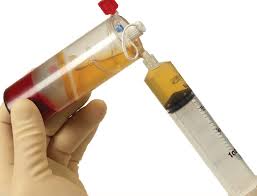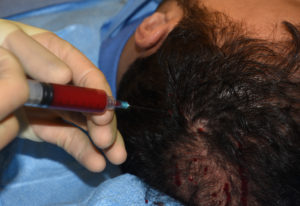Hair loss is incredibly common for both men and women. The use of non-surgical topical Minoxidil and oral Propecia as well as surgical hair tranplantation are well known and offer hair maintenance and hair restoration benefits to many. But between these two type of treatmets lies an intermediate hair therapy that has been historically lacking…a form of injectable therapy. That role is now beginnning to be filled with PRP therapy. PRP injections are a non-surgical method of hair stimulation that can be used for both men and women.

How does PRP for hair growth work? It is postulated that PRP can cause the growth of hair through stimulation of the stem cells located in the dermal papilla of the hair follicle.(bulb) It is very likely that it may stimulate other structures in the hair follicle as well. PRP may induce a hair follicle to change from the resting staten (telogen) to the growth phase.(anagen) This may ‘wake up’ dormant hair follicle and/or may cause active ones to grow faster or develop slightly thicker hair shafts.

Who is a good candidate for PRP hair regeneration? While individual results vary and no guarantee can be given that hair will grow, PRP works best in thinning hair. It will not take a ‘desert’ and turn it into a lush garden. It is not a magic potion that can make hair appear that has been completely absent for decades. Rather it requires some follicles to be present for its stimulatory effects to be seen. This is why it works just as well for women (maybe even better than men) because they may have more active follicles initially anyway. PRP is a good adjunctive therapy to be used both before and after hair transplantation. It is also an excellent treatment for those patients who have lost their hair from chemotherapy. (follicles induced into telogen by chemical poisons)
PRP is an emerging non surgical based therapy for natural stimulation for thinning hair. PRP is completely safe and natural because it contains the patient’s own blood product. The scientific evaluation of the effectiveness of PRP therapy for hair regeneration is currently under clinical trial investigation and its efficacy is currently based on anectodal and case report evidence only. Thus it should not be considered FDA approved or view as a ‘baldness cure’.
PRP therapy is a natural alternative for improving hair growth for those patients who do not want surgical hair transplantation. Conversely it is also an adjunctive therapy for those that have already undergone hair transplants. Although results will vary from patient to patient, PRP injections offer improvement in hair caliber and thickness for natural thinning and miniaturization or as a stimulus for newly implanted follicles.
Dr. Barry Eppley
Indianapolis, Indiana


